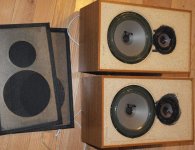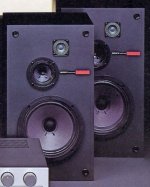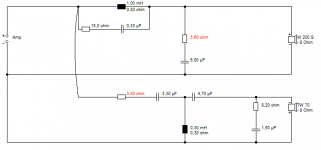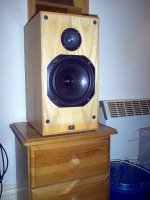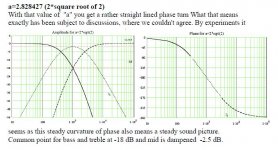I think you have done very appreciable works about average and peak signal values of commercial records. Statistics show that a 16-20 dB ratio is common for fairly good records.
Considering the usual background noise of listening rooms and the usual average listening levels, we can determine the objective dynamic range necessary for what is called high fidelity sound reproduction :
loudspeakers are rarely a limiting factor. It they are, it is audible and it means that they are undersized for the levels demanded...It has been argued that high fidelity systems should be able to reproduce the "realistic" levels of concerts. What levels at what concerts ?
Reproducing at home the SPL peaks perceived by a listener of classical concerts is affordable - but usually not desired - to most systems...Numerous estimations and experiences with real musical signals show it is unimportant in domestic conditions. If voice coils are considered as compressors, they do not behave like the familiar electronic ones : their thermal constant is measured in tens of seconds, not in tenths of second.
Regards.
To say that "dynamic" doesn't include true dynamics is a rather odd discussion.
These are interesting points but not really relevant to this OP's question. If you are trying to lead the answer to include your particular favorite loudspeaker design philosophy (and we get that discussion in 99.9% of all other DIYAudio discussions), then I guess that I can see your logic. Otherwise, it seems a bit tortured.
To say that you don't need really dynamic capabilities in a loudspeaker because of typical limitations of commercially bought music, or that it "costs too much" (again implying that truly dynamic loudspeakers are "unaffordable") isn't really true, is it? The most dynamic loudspeakers that I've heard are half the price of "tower" loudspeakers.
To say that most recordings are compressed, so you don't actually need dynamics, is again begging the question. To say that rooms are too noisy to hear true dynamics, again, that's making an assumption that is sweeping, general, and not true.
If you live in a small and noisy apartment or flat whereby your neighbors will start banging on the walls if you play your loudspeakers at more than 85 dBC at your listening position...that isn't my idea of "hi-fi" or "dynamic reproduction" but it may be a limitation for some people.
However, I'm glad that I don't have those limitations. I also use my system for multichannel use (including but limited to home cinematic use), and it is extremely dynamic and useful for such applications.
Chris
Perhaps DIYAudio actually needs a "high efficiency/dynamic loudspeaker" forum, like Audio Asylum? That would definitely attract a different demographic to the Loudspeaker forums that seemingly is without home presently. To have one discussion that is clearly related to this general area has been an effort thus far.
It could be the high sensitivity of PA woofers, or simply power headroom of the big amplifier driving it. Most of the time, it is a combination of many well known variables.
I'm not sure if you have really understood what I'm talking about. "Sounding" dynamic has in most cases, at least in my experience, nothing to do with real dynamic, but more with speaker/room problems and biased perception. The bias may come from visual appearance of the speaker, something like the story with the VU meter, etc...
Dynamic range, the difference between the quietest and loudest sound, is a factor in a speaker sounding dynamic. For example, you are listening to an orchestra. The speaker reproducing the orchestra with a dynamic range of 30db is going to sound more dynamic than a speaker with a range of 20db.
The other factor is transient response. A speaker with a faster and higher transient response is going to sound more dynamic (or exciting) than a speaker which is a bit lower in response.
These two together can create a fast, exciting and dynamic sound.
Generally how you get this is a from light cones and/or the speed and range with which they can react to an input signal; low distortion and low colouration are also significant factors as they lower the noise floor.
Of course, it all depends to a great extent on the quality of the source material and the capabilities of the electronics used.
The other factor is transient response. A speaker with a faster and higher transient response is going to sound more dynamic (or exciting) than a speaker which is a bit lower in response.
These two together can create a fast, exciting and dynamic sound.
Generally how you get this is a from light cones and/or the speed and range with which they can react to an input signal; low distortion and low colouration are also significant factors as they lower the noise floor.
Of course, it all depends to a great extent on the quality of the source material and the capabilities of the electronics used.
Dynamic range, the difference between the quietest and loudest sound, is a factor in a speaker sounding dynamic. For example, you are listening to an orchestra. The speaker reproducing the orchestra with a dynamic range of 30db is going to sound more dynamic than a speaker with a range of 20db.
Yes, but that difference does not come from loudspeakers! Differences in speakers' power compression are actually very small, max say 2dB. Problematic impedance curve and limited max power (spl) handling cause this.
SoundStage measures power compression, results are published here SoundStageNetwork.com | SoundStage.com | SoundStageNetwork.com | SoundStage.com
What makes a speaker sound dynamic?
The most important element is the music itself, IMO. Secondly, the dynamic range of the recording/mastering.
All the rest is variable, based on desired power/SPL, size/shape/composition of room, etc. etc. etc.
The most important element is the music itself, IMO. Secondly, the dynamic range of the recording/mastering.
All the rest is variable, based on desired power/SPL, size/shape/composition of room, etc. etc. etc.
Dynamic range, the difference between the quietest and loudest sound, is a factor in a speaker sounding dynamic. For example, you are listening to an orchestra. The speaker reproducing the orchestra with a dynamic range of 30db is going to sound more dynamic than a speaker with a range of 20db.
The other factor is transient response. A speaker with a faster and higher transient response is going to sound more dynamic (or exciting) than a speaker which is a bit lower in response.
These two together can create a fast, exciting and dynamic sound.
Generally how you get this is a from light cones and/or the speed and range with which they can react to an input signal; low distortion and low colouration are also significant factors as they lower the noise floor.
Of course, it all depends to a great extent on the quality of the source material and the capabilities of the electronics used.
This is pretty close to a definition that I can accept without exception.
Generally how you get this is a from light cones and/or the speed and range with which they can react to an input signal;
Perfect example for what I meant...
Zuhl, think about F=m*a, and what happens to "a" (and "v", and "x") when "F" is increased.
Still want light cones?
Perfect example for what I meant...
Zuhl, think about F=m*a, and what happens to "a" (and "v", and "x") when "F" is increased.
Still want light cones?
A transformer action that basically uses air as the expander medium coupled to a higher impedance compression driver of stout construction (i.e., not like the low force factor/area of a electrostatic or dynamic diaphragm dipole radiator) effectively yields a "light cone" without the corresponding harmonic or modulation distortion that you would get from big moving cones: the horn-loaded compression driver (including woofers used in compression loading while connected to a suitable horn).
F= m*a --> a = m/F
As F = (Bl)*i, if you double both m and i, a does not change.
Light cones are good for efficiency but are not a guarantee that the acceleration of the moving part is better behaved and more in accordance with the input signal, and then that impulses are better reproduced. That's basic physics.
As F = (Bl)*i, if you double both m and i, a does not change.
Light cones are good for efficiency but are not a guarantee that the acceleration of the moving part is better behaved and more in accordance with the input signal, and then that impulses are better reproduced. That's basic physics.
I'm a bit of a tart, I know, but I don't solely hang around this forum looking for inspiration...😀
We had a guy at another place who chanced upon some Solarvox TK 19S speakers. Pictured below. These were made by Tandberg of Oslo, Norway back in the seventies using SEAS drivers. 8" SEAS 21TV-GW 8 ohm bass, and 3.5" SEAS 9TV-LG 15 ohm cone tweeter crossed at 3kHz.
Here's the thing, these speakers are exceptionally efficient along with having small voicecoils which give extended frequency response, transparent dustcaps and light weight and corrugated surrounds. We needn't go into cone tweeters. In fact Troels Gravesen had some fun with a 4 ohm variant:
BLACKCONES
I'd suspect those voicecoil formers aren't damping aluminium. AlNiCo magnets? I couldn't say how important that is. But I'd suspect the shallow crossovered Rectilinear XII is a direct descendant, a three-way being easier, whether series or parallel crossover. Interesting? A flat frequency response doesn't tell you everything about a lively sound IMO. 🙂
We had a guy at another place who chanced upon some Solarvox TK 19S speakers. Pictured below. These were made by Tandberg of Oslo, Norway back in the seventies using SEAS drivers. 8" SEAS 21TV-GW 8 ohm bass, and 3.5" SEAS 9TV-LG 15 ohm cone tweeter crossed at 3kHz.
Here's the thing, these speakers are exceptionally efficient along with having small voicecoils which give extended frequency response, transparent dustcaps and light weight and corrugated surrounds. We needn't go into cone tweeters. In fact Troels Gravesen had some fun with a 4 ohm variant:
BLACKCONES
I'd suspect those voicecoil formers aren't damping aluminium. AlNiCo magnets? I couldn't say how important that is. But I'd suspect the shallow crossovered Rectilinear XII is a direct descendant, a three-way being easier, whether series or parallel crossover. Interesting? A flat frequency response doesn't tell you everything about a lively sound IMO. 🙂
Attachments
So the original question was about dynamic sounding bookshelf speakers?
With reference to
http://www.diyaudio.com/forums/mult...-makes-speaker-sound-dynamic.html#post4337778
if we detach the subjective concept of "dynamic" from the relations to the objective facts that are "dynamic range" and "dynamics", and interpret it as "lively", "full of vitality and energy", the initial question looses its ambiguity.
It excludes the artificial antagonism between high and low loudspeaker efficiencies from the debate.
The kind of drivers I very much appreciate for liveliness is the one presented by xrk971 in his recent threads of subjective blind comparison of small drivers. It is a preference, nothing else.
Last edited:
system7, I am also in love with those vintage SEAS alnico drivers.
sony had speakers made in scandinavia with the same drivers too.
the problem was that, at the time of those alnico drivers, crossovers were typically first order with awful capacitors. those cannot handle high spl at all.
later sony switched to the ferrite versions of the same drivers with upgrades to second order crossovers (eg. sony ss-2030). Not bad.
however the older alnico drivers work like magic when updated with high order co or DSP.
sony had speakers made in scandinavia with the same drivers too.
the problem was that, at the time of those alnico drivers, crossovers were typically first order with awful capacitors. those cannot handle high spl at all.
later sony switched to the ferrite versions of the same drivers with upgrades to second order crossovers (eg. sony ss-2030). Not bad.
however the older alnico drivers work like magic when updated with high order co or DSP.
Since most everybody else simply doesn't get what this thread is about, zmyrna, we might as well have a private conversation here. I simply don't know how a comment like "nt" advances things. 🙂system7, I am also in love with those vintage SEAS alnico drivers.
sony had speakers made in scandinavia with the same drivers too.
the problem was that, at the time of those alnico drivers, crossovers were typically first order with awful capacitors. those cannot handle high spl at all.
later sony switched to the ferrite versions of the same drivers with upgrades to second order crossovers (eg. sony ss-2030). Not bad.
however the older alnico drivers work like magic when updated with high order co or DSP.
Dynamics is about a loudspeaker's ability to make you jump, and surprise you sometimes! Maybe a trumpet or a vocal just jumps into the room. 😎
Very little to do with crossovers IMO. More the drivers. Most of the good bass units used paper formers. Not good on power handling, but DYNAMIC.
Like the Gale GS401A:
An externally hosted image should be here but it was not working when we last tested it.
And the Wharfedale E70:
An externally hosted image should be here but it was not working when we last tested it.
In fact that goes for the mids and tweeters too. Because the original poster did ask what we thought made for a dynamic speaker. Your Sony ss-2030 looks promising, below.
I stick with high Qms. So does Troels Gravesen:
JA8008-HMQ
You are right the old speakers had shockingly bad and simplistic crossovers. As you say, give them something half decent and they shine:
TQWT-
A horn-loaded dome tweeter isn't the only game in town though. I like this two way sort of 8" bass circuit with a cone tweeter, and don't forget the best cone tweeters used an aluminium dome. You have to find the right woofer and tweeter though, IMO, because otherwise you just think it fails badly. FWIW, I'd consider three ways just plain easier, you can get away with shallower crossovers.
Attachments
Dynamics is about a loudspeaker's ability to make you jump, and surprise you sometimes! Maybe a trumpet or a vocal just jumps into the room. 😎
It's a subjective perception, and the original question was what makes it so.
Very little to do with crossovers IMO. More the drivers. Most of the good bass units used paper formers. Not good on power handling, but DYNAMIC.
It has something to do with a lot of things (as has been said here by various posters), including crossovers, which I cannot say a "little" when we are dealing with the high end, trying to get the last bit. But from general perspective (meaning we are not at the high end region) I think I would agree.
Crossovers will kill sensitivity. The more power wasted in XO components, the less dynamics it is.
Wrong phase relationship between woofer and tweeter responses, etc...
Most of the good bass units used paper formers. Not good on power handling, but DYNAMIC.
What do you mean with paper former?? Is it "bakelite" or something like it I forgot the name. Yes, it is good for midrange but for low bass we need to dissipate the heat with aluminum former (to avoid thermal compression issue for example).
May be this dynamics you notice has nothing to do with the paper former (directly)?
you really shouldn't try on these bad heuristics where real engineers can read them
no the power 'wasted" can be simply the circuit requirement for the correct alignment, frequency response - damping is power "wasting"
The more power wasted in XO components, the less dynamics it is.
no the power 'wasted" can be simply the circuit requirement for the correct alignment, frequency response - damping is power "wasting"
you really shouldn't try on these bad heuristics where real engineers can read them
I knew. So they will have problem because of this? 😀
no the power 'wasted" can be simply the circuit requirement for the correct alignment, frequency response
What's the difference...
- Status
- Not open for further replies.
- Home
- Loudspeakers
- Multi-Way
- Discussion - What makes a speaker sound dynamic
